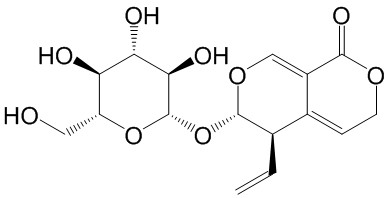Home
Products
Gentiopicroside



| Product Name | Gentiopicroside |
| Price: | $23 / 20mg |
| Catalog No.: | CN03167 |
| CAS No.: | 20831-76-9 |
| Molecular Formula: | C16H20O9 |
| Molecular Weight: | 356.3 g/mol |
| Purity: | >=98% |
| Type of Compound: | Iridoids |
| Physical Desc.: | Powder |
| Source: | The roots of Gentiana manshurica Kitag. |
| Solvent: | DMSO, Pyridine, Methanol, Ethanol, etc. |
| SMILES: | C=C[C@H]1[C@@H](OC=C2C1=CCOC2=O)O[C@@H]1O[C@H](CO)[C@H]([C@@H]([C@H]1O)O)O |
| Contact us | |
|---|---|
| First Name: | |
| Last Name: | |
| E-mail: | |
| Question: | |
| Description | Gentiopicroside, a naturally occurring iridoid glycoside, inhibits P450 activity, with an IC50 and a Ki of 61 µM and 22.8 µM for CYP2A6; Gentiopicroside has antianti-inflammatoryand antioxidative effects. |
| Target | IC50: 61 µM (CYP2A6)[1] Ki: 22.8 µM (CYP2A6)[1] |
| In Vitro | Gentiopicroside inhibits P450 activity, with an IC50 and a Ki of 61 µM and 8.12 µM for CYP2A6, also slightly inhibits CYP2E1 activity with an IC50 of 1.6 mM, but shows no inhibition on CYP1A2 and CYP3A4[1]. Gentiopicroside (12.5, 25 and 50 μM) inhibits RANKL-induced osteoclast formation from mouse bone marrow macrophages (BMMs) in a dose-dependent manner, blocks the expression of osteoclast-related proteins, prevents receptor activator of nuclear factor-κB ligand (RANKL)-triggered JNK and NF-κB activation. Gentiopicroside (50 μM) also inhibits RANKL-induced bone resorption[3]. |
| In Vivo | Gentiopicroside (20, 40, and 80 mg/kg, p.o.) significantly reduces gastric ulcerindex in mice. Gentiopicroside (20, 40, and 80 mg/kg) also ovbiously decreases the levels of HSP-70, TNF-α, IL-6, MDA and increases ncreased GSH level and SOD activity. In addition, Gentiopicroside normalizes EGF and VEGF level in mice[2]. |
| Cell Assay | Cell viability is evaluated using the CCK-8 assay. In brief, bone marrow macrophages (BMMs) (1 × 104 cells/well) are placed in a 96-well plate and cultured with various concentrations of Gentiopicroside (12.5, 25 and 50 μM) for 48 h in the presence of M-CSF (30 ng/mL) and RANKL (100 ng/mL). Then, 10 μL of the CCK-8 solution is added to each well and the mixture is incubated for 4 h at 37 °C. The absorbance is evaluated at 450 nm using a microplate reader[3]. |
| Animal Admin | Mice[2] Mice are ran-domLy divided into six groups with 10 animals each. Drug is given by intragastric administration once a day for three consecutive days. Mice in the normal control group and the ethanol control group (negative control) receive saline at a dose of 2.5 mL/kg; Mice in the cimetidine control group (positive control) receive cimetidine at a dose of 100 mg/kg; mice in three Gentiopicroside investigative groups receive different doses of Gentiopicroside (20, 40, and 80 mg/kg), respectively; On the third day, except that mice in the normal control group receive saline, mice in other groups receive 70% ethanol at a dose of 0.01 mL/g by oral1 hr after the last intragastric administration. One hour after the induction, animals are euthanized under anesthesia by cervical dislocation, removed and cut the stomach longitudinally. The stomach are opened along the greater curvature and rinsed slightly with ice-cold saline to remove the gastric contents, and then the severity of gastric mucosal injury is evaluated by gastric ulcer index. Subsequently, each animal'sstomach is cut into two moieties, with one moiety of stomach stored at −80°C for biochemical assessment and the other moiety immersed in 4% paraformaldehyde solution for histopathological examinations[2]. |
| Density | 1.5±0.1 g/cm3 |
| Boiling Point | 667.8±55.0 °C at 760 mmHg |
| Flash Point | 247.1±25.0 °C |
| Exact Mass | 356.110718 |
| PSA | 134.91000 |
| LogP | -3.17 |
| Vapour Pressure | 0.0±4.6 mmHg at 25°C |